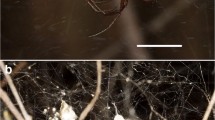Abstract
Body size largely determines the outcome of male-male competition in the banksia bee,Hylaeus alcyoneus. Large males invariably perch on and defend banksia flower spikes, whereas smaller males often nonaggressively patrol circuits that take them repeatedly to several flower spikes. Within the population of males perching on banksia spikes, larger individuals tend to monopolize inflorescences that are higher in banksia shrubs, whereas smaller males often occupy spikes closer to the ground. Perches defended by larger males are more quickly occupied by replacements when the original residents are experimentally removed and held in temporary captivity. When released, the original residents invariably return to and displace the smaller replacements that have taken their territories. When territory takeovers do occur, the winner is almost always larger than the previous resident, showing that residency effects are secondary to body size in determining territorial ownership.
Similar content being viewed by others
References
Alcock, J. (1990). Body size and territorial behavior in the beeProtoxaea gloriosa (Fox) (Hyme noptera: Oxaeidae).Pan-Pac. Entomol. 66 157–161.
Alcock, J., and Houston, T. F. (1987). Resource defense and alternative mating tactics in the banksia bee,Hylaeus alcyoneus (Erichson).Ethology 76 177–188.
Alcock, J., Eickwort, G. C., and Eickwort, K. R. (1977a). The reproductive behavior ofAnthidium maculosum (Hymenoptera: Megachilidae) and the evolutionary significance of multiple copulations by females.Behav. Ecol. Sociobiol. 2 385–396.
Alcock, J., Jones, C. E., and Buchmann, S. L. (1977b). Male mating strategies in the beeCentris pallida Fox (Hymenoptera: Anthophoridae).Amer. Nat. 111 145–155.
Danforth, B. (1991). The morphology and behavior of dimorphic males inPerdita portalis (Hymenoptera: Andrenidae).Behav. Ecol. Sociobiol. 29 235–247.
Hastings, J. M. (1989). The influence of size, age, and residency status on territory defense in male western cicada killer wasps (Sphecius grandis, Hymenoptera: Sphecidae).J. Kans. Entomol. Soc. 62 363–373.
Huntingford, F., and Turner, A. (1987).Animal Conflict, Chapman and Hall, London.
O'Neill, K. M. (1983). The significance of body size in territorial interactions of male beewolves (Hymenoptera: Sphecidae,Philanthus).Anim. Behav. 31 404–411.
O'Neill, K. M. (1985). Egg size, prey size, and sexual size dimorphism in digger wasps.Can. J. Zool. 63 2187–2193.
Pfennig, D. W., and Reeve, H. K. (1989). Neighbor recognition and context-dependent aggression in a solitary wasp,Sphecius speciosus (Hymenoptera: Sphecidae).Ethology 80 1–18.
Polak, M. (1993). Competition for landmark territories among malePolistes canadensis (L.) (Hymenoptera: Vespidae): Large-size advantage and alternative mate-acquisition tactics.Behav. Ecol. 4 325–331.
Severinghaus, L., Kurtak, B. H., and Eickwort, G. C. (1981). The reproductive behavior ofAnthidium manicatum (Hymenoptera: Megachilidae) and the significance of size for territorial males.Behav. Ecol. Sociobiol. 9 51–58.
Stern, D. L. (1991). Male territoriality and alternative male behaviors in the euglossine bee,Eulaema meriana (Hymenoptera: Apidae).J. Kans. Entomol. Soc. 64 421–437.
Sugiura, N. (1991). Male territoriality and mating tactics in the wool-carder bee,Anthidium septemspinosum Lepeletier (Hymenoptera: Megachilidae).J. Ethol. 9 95–103.
Thornhill, R., and Alcock, J. (1983).The Evolution of Insect Mating Systems, Harvard University Press, Cambridge, MA.
Author information
Authors and Affiliations
Rights and permissions
About this article
Cite this article
Alcock, J. Body size and its effect on male-male competition inHylaeus alcyoneus (Hymenoptera: Colletidae). J Insect Behav 8, 149–159 (1994). https://doi.org/10.1007/BF01988901
Accepted:
Issue Date:
DOI: https://doi.org/10.1007/BF01988901




